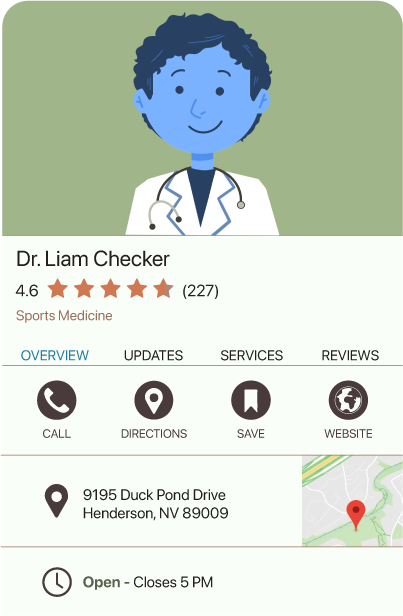Healthcare used to be a field where the volume of services dictated success, with the main focus on physicians. However, it has moved towards a quality-based approach, centering around the patient. Now, providing excellent care is just a part of the equation. The other crucial part is effectively reaching and attracting your patients.
Want to get ahead of the curve? Create a healthcare marketing strategy that connects with customers and converts them into loyal patients.
Instead of a passive approach, build a long-term solution with a marketing strategy that works for you. Ensure that your marketing efforts produce measurable results and maximize your Return on Investment (ROI). Creating a healthcare marketing strategy focused on ROI isn’t just a good practice — it’s necessary to stay competitive and sustainable in today’s healthcare market.
Strategic Healthcare Marketing Approach
Like any other business, you need different ways to spread the word about your facilities, services, and treatments. The healthcare system is complex, with many different components, treatments, and procedures, which can overwhelm the average consumer. Healthcare marketing aims to bridge this gap by using creative strategies to engage and educate patients.
This is especially critical since consumer behavior has changed. People no longer solely rely on referrals, word of mouth, and traditional marketing when searching for a healthcare provider. Modern consumers have taken ownership of their healthcare journey and research and evaluate providers based on data they find online.
In fact, 69% of millennial patients would turn to the web for medical advice instead of their primary care physician. That’s why you need to create a healthcare marketing strategy that’s targeted and data-driven. With the right approach and tools, you can have the upper hand in attracting new patients and retaining old ones.
Healthcare marketing also aims to drive high-quality leads, increase revenue, and maintain healthy profit margins. To achieve these results, your strategy must include multiple channels to reach more potential patients, as well as comprehensive analytics to measure them and adjust accordingly.
Steps to Create a Healthcare Marketing Strategy that Delivers Results
 Managing the financial constraints of the healthcare industry is a challenge familiar to many. With budgets often tight, the sector demands a high level of responsibility and accountability. Stakeholders, from hospital administrators to department heads, analyze every cost and expect to see tangible value and returns on every dollar invested, especially when it comes to marketing initiatives.
Managing the financial constraints of the healthcare industry is a challenge familiar to many. With budgets often tight, the sector demands a high level of responsibility and accountability. Stakeholders, from hospital administrators to department heads, analyze every cost and expect to see tangible value and returns on every dollar invested, especially when it comes to marketing initiatives.
Without a focus on ROI, even the most well-intentioned marketing efforts risk becoming an ineffective use of resources. In other words, it’s imperative to create a healthcare marketing strategy that’s not just operational but also financially effective.
Set Your Goals
Before you create a healthcare marketing strategy, you have to define your goals and what you hope to achieve. Whether it’s increasing patient volume, improving patient satisfaction, or promoting specific services, setting clear and measurable goals is a crucial first step. This approach allows you to track your progress and determine the effectiveness of your marketing efforts.
Let’s say a dental practice decides to create a healthcare marketing strategy with the specific goal of increasing new patient registrations by 20% in the next six months. To achieve this, they plan to launch a digital marketing campaign focusing on social media and local SEO. They can measure the effectiveness of the campaign by the number of new patient forms submitted through their website and increase in phone inquiries. This gives direction to their marketing efforts but also provides a clear benchmark for success, allowing them to evaluate and adapt their strategy for maximum impact.
Know Your Audience
A fundamental component when you create a healthcare marketing strategy is understanding your audience. For healthcare businesses, it’s crucial to identify who their ideal patients are because tailoring marketing messages to resonate with these specific groups can significantly improve the effectiveness of your efforts. This process involves conducting thorough market research, analyzing existing patient data, and developing detailed patient personas.
A patient persona is essentially a fictional representation of your ideal patient, but it’s grounded in real data about your target audience. This includes information such as their age, gender, location, prevalent health concerns, and lifestyle habits. Creating a healthcare marketing strategy based on this information ensures that your messaging is accurate as well as empathetic and engaging, directly addressing the specific needs and concerns of your audience.
Develop a Multi-Channel Strategy
A fundamental component when you create a healthcare marketing strategy is selecting the appropriate mix of marketing methods. The right combination should align with your target audience’s preferences, budget constraints, and the specific goals you want to achieve.
If your budget is tight, focus on cost-effective healthcare marketing strategies. Social media marketing and content marketing can be great starting points, as they often require less financial investment while still offering significant reach and engagement. These methods also allow for direct communication with your audience, fostering a sense of community and trust in your healthcare brand.
 In addition to this, local SEO is an incredibly powerful and cost-effective tool. Optimizing your Google Business Profile (GBP) and ensuring your practice appears prominently in local search results requires more of your time than money. Leveraging local directories and maintaining consistent NAP (Name, Address, Phone Number) information across various online platforms also boosts your local SEO efforts. These steps, while not financially demanding, can significantly enhance your online visibility and patient reach.
In addition to this, local SEO is an incredibly powerful and cost-effective tool. Optimizing your Google Business Profile (GBP) and ensuring your practice appears prominently in local search results requires more of your time than money. Leveraging local directories and maintaining consistent NAP (Name, Address, Phone Number) information across various online platforms also boosts your local SEO efforts. These steps, while not financially demanding, can significantly enhance your online visibility and patient reach.
As your marketing efforts start yielding results and your budget grows, you can diversify your approach. Pay-per-click (PPC) advertising can be particularly effective in driving targeted traffic to your website while investing in professional website design and advanced SEO strategies can further enhance your online presence. You can also consider incorporating predictive patient targeting into your approach for more precise targeting and personalization, reaching potential patients based on their procedure needs.
Improve Patient Experience
66% of people feel that healthcare providers seem more rushed than they have been in the past, and 65% feel overwhelmed by the responsibilities of managing their healthcare. Things shouldn’t be this way – and they don’t have to be.
When you create a healthcare marketing strategy, a central focus should be on creating real value for patients, leading to more meaningful and profitable patient engagement. By identifying different touchpoints – from the first online search to post-treatment follow-ups – you can customize each interaction to enhance patient satisfaction and strengthen the bond between you and your patients.
A comprehensive, patient-centered healthcare marketing strategy ensures that every engagement point resonates with your brand’s values and goals. This alignment also creates an environment where your patients feel understood, valued, and cared for at every step.
Use Data to Measure Success
Using data for measuring success and guiding improvements is another critical step when you create a healthcare marketing strategy. Many healthcare providers shy away from data analysis because of HIPAA restrictions. However, not only is it possible (with the right toolset)—it’s essential to track key metrics such as lead generation rates, Patient Acquisition Costs (PAC), and ROAS (return on ad spend) to get a clear picture of the ROI of your marketing efforts.
With the help of this data, you gain insights into which aspects of your healthcare marketing strategy are working well and which areas need adjustment. For example, if certain types of content or specific channels are driving more patient engagement and leads, you can focus more resources on these areas for better impact. In turn, if some campaigns show lower returns, you can reassess and redirect efforts to more productive strategies.
Incorporating a data-driven approach when you create a healthcare marketing strategy ensures that decisions are based on tangible evidence rather than guesswork. By continuously monitoring and analyzing different metrics, you can adapt and evolve your approach to better meet the needs of your patients and the goals of your healthcare organization.
Optimize Your Healthcare Marketing Strategy
An integral part of the process when you create a healthcare marketing strategy is the continuous optimization of your efforts to maximize ROI. With the data you’ve gathered from your marketing campaigns, you can effectively fine-tune your strategy. This involves refining your messaging to better resonate with your target audience, focusing on specific channels that yield the best results, and experimenting with various tactics to identify the most effective approaches.
At the same time, the optimization process must be ongoing. Continuously monitoring your campaign results and analyzing data allows you to make informed decisions and adjust your strategies proactively. This helps you achieve better results in the short term but also paves the way for sustainable long-term success.
Drive Growth and Engagement
In today’s healthcare environment, the true measure of a successful marketing strategy lies in its ability to generate a high ROI. It’s not enough to just spread the word about your services—you need to do so in a way that maximizes both patient engagement and financial returns.
This approach demands a strategic alignment of your efforts with the economic realities of your healthcare organization. By focusing on ROI, you make sure that each element of your strategy—from understanding your audience to optimizing your multi-channel approach—contributes to your overall business objectives.
All of this can be rather challenging and time consuming: a healthcare-specific marketing platform can help. SocialClimb offers you a comprehensive healthcare marketing platform that allows you to manage all of the different aspects of your healthcare marketing strategy in one place.
With our platform, you can measure your key marketing metrics, improve your online reputation, find high-value patients in your area, and ultimately improve profitability at your practice. Learn more about SocialClimb’s tools here.











